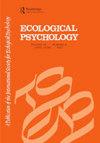摆动门不变量:来自旋转面板的光学信息
IF 1.7
3区 心理学
Q3 PSYCHOLOGY, EXPERIMENTAL
引用次数: 5
摘要
生态知觉研究的重点是刺激阵列不变量作为可能指导生物体(特别是人类)行为的信息。建筑环境由人类主体构建,其结构规律(如平面性、垂直性、水平性、正交性)约束着刺激阵列信息;这里的重点是光学信息(不变量)。人造环境包含限制行为的障碍;门允许通过这种障碍。门(更普遍的是,摆动的面板)产生的光学信息惊人地多。具体来说,不变量存在于(a)面板碰撞和绕过,(b)面板的旋转轴,(c)水平线,以及(d)面板的正面平行方向。功能支持与每一个都相关联。所描述的不变量举例说明了元不变量模式(即,在不同的环境对象和事件中发生的不变刺激数组结构的相似性);元不变量可以作为在限定上下文中发现不变量的研究启发式。描述了确定的光学不变量的经验考虑。所描述的推导也可能有助于教授刺激数组变换的不变量概念。本文章由计算机程序翻译,如有差异,请以英文原文为准。
Swinging Door Invariants: Optical Information from Rotating Panels
Abstract Ecological perceptual research focuses on stimulus array invariants as information that might guide organismic (particularly human) actions. Constructed by human agency, built environments entail structural regularities (e.g., planarity, verticality, horizontality, orthogonality) that constrain stimulus array information; here the emphasis is optical information (invariants). Built environments involve barriers that restrict behavior; doors allow passage through such barriers. Doors (more generally, swinging panels) yield surprisingly many instances of optical information. Specifically, invariants exist for (a) panel collision and bypass, (b) the panel’s axis of rotation, (c) the horizon line, and (d) the panel’s frontal-parallel orientation. Affordances are associated with each of those. Invariants described exemplify meta-invariant patterns (i.e., similarities in invariant stimulus array structure that occur across disparate environmental objects and events); meta-invariants may serve as research heuristics for the discovery of invariants in delimited contexts. Empirical considerations for optical invariants identified are described. Derivations described may be helpful for teaching the concept of invariants from stimulus array transformations, as well.
求助全文
通过发布文献求助,成功后即可免费获取论文全文。
去求助
来源期刊

Ecological Psychology
PSYCHOLOGY, EXPERIMENTAL-
CiteScore
3.30
自引率
10.50%
发文量
8
期刊介绍:
This unique journal publishes original articles that contribute to the understanding of psychological and behavioral processes as they occur within the ecological constraints of animal-environment systems. It focuses on problems of perception, action, cognition, communication, learning, development, and evolution in all species, to the extent that those problems derive from a consideration of whole animal-environment systems, rather than animals or their environments in isolation from each other. Significant contributions may come from such diverse fields as human experimental psychology, developmental/social psychology, animal behavior, human factors, fine arts, communication, computer science, philosophy, physical education and therapy, speech and hearing, and vision research.
 求助内容:
求助内容: 应助结果提醒方式:
应助结果提醒方式:


